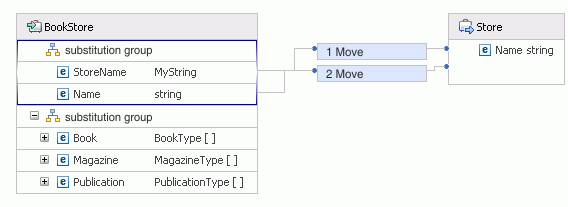IBM BPM, V8.0.1, All platforms > Authoring services in Integration Designer > Defining and transforming data > Transforming data > Transforming data using a business object map
Mapping substitutable elements
A substitutable element is an XML element that declares another element to be its head element, by using the substitution group construct. The substitutable element can then be used instead of the head element. The substitutable element must be of the same type as or derived from a parent element. You can map a substitutable element in the business object map editor.
In the business object map editor, elements that belong to a substitution group are shown under a substitution group tree.

As the above example shows, you can select an element in a substitution group and map it to an element in another business object. As in all business object maps, the run order of the transform is significant here as well. However, for substitution groups there is another consideration. Let’s assume that when this business object map is run, the instance data that comes into the map is of type StoreName. This will cause both transformations to run over the same instance data, and there is potential for the second transform to override the operation performed by the first transform.
Consider the mapping shown in the following diagram, where only the head element Name is mapped.

Since the head element is mapped with a Move transformation, regardless of whether Name or StoreName is present on the instance data coming in during runtime of the map, the Move transform will always run. Therefore, you only need to define one type of mapping to handle all substitution group members.
You can also map substitutable elements in the XML map editor. If that the result of executing an XML map of a head element may be different than the result of executing a business object map of a head element.